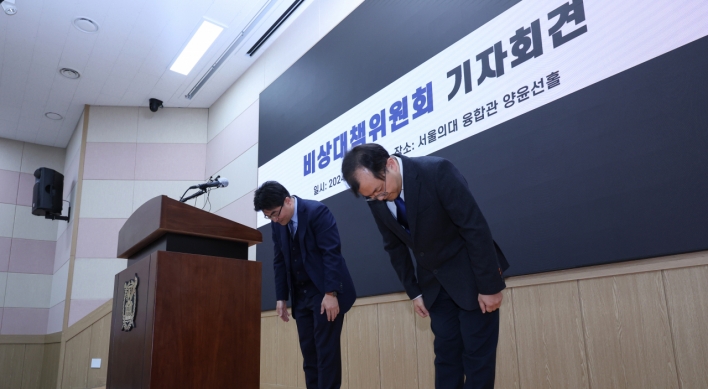The slump in private consumption and exports has undermined small and medium-sized enterprises in terms of the capacity utilization of their factories, a bank-based think tank said Monday.
A survey by IBK Economic Research Institute on 3,169 SMEs showed that their factory operating rate posted 70.2 percent in August, down 1.2 percentage points from a year earlier. Many of the respondents cited their huge inventories for the low rate.
The factory operating rate, which peaked at the yearly average of 73.7 percent in 2011, has continued to fall to 73.1 percent in 2012, 72.7 percent in 2013 and 72.4 percent in 2014.
This year, the outbreak of the Middle East respiratory syndrome in May and June and the negative on-year growth in exports are estimated to have worsened the situation.
When figures for each February ― when the number of operating days are generally low due to Lunar New Year holidays ― are excluded, the 70.2 percent in August marked the lowest in six years since it stood at 68.9 percent in August 2009.
In addition, 31 percent of the respondents said their cash flow condition has deteriorated. As for the reason for their worsening financial condition, sagging domestic sales (which was linked to huge stocks) was picked by 81.8 percent, delayed payment for goods by 32.4 percent and lackluster exports by 17.2 percent.
As the ratio of SMEs who responded that their financial condition is sound stayed at 4.5 percent, the gap with those picking worsening conditions has further widened to reach 26.5 percent. It is the largest gap in 30 months after it peaked at 27.6 percent in February 2013.
Meanwhile, economic policymakers are striving to vitalize the consumer sentiment. Among the recent stimulus measures were the Korea Black Friday event and a consumption tax cut for automobiles buyers.
A majority of economists say the ongoing slump in private consumption is attributable to the nation’s record consumer debt.
“The growth of household debt is outpacing that of household income. This could be unfavorable for future consumer spending,” said a research fellow of LG Economic Research Institute.
According to the Bank of Korea, the ratio of household debt to national disposable income has come to 159.4 percent, far surpassing the average of 132.5 percent held by 34 members of the Organization for Economic Cooperation and Development at the end of 2012.
Outstanding household debt has snowballed to exceed 1.13 quadrillion won ($989 billion), as of June 2015.
By Kim Yon-se (kys@heraldcorp.com)
A survey by IBK Economic Research Institute on 3,169 SMEs showed that their factory operating rate posted 70.2 percent in August, down 1.2 percentage points from a year earlier. Many of the respondents cited their huge inventories for the low rate.
The factory operating rate, which peaked at the yearly average of 73.7 percent in 2011, has continued to fall to 73.1 percent in 2012, 72.7 percent in 2013 and 72.4 percent in 2014.
This year, the outbreak of the Middle East respiratory syndrome in May and June and the negative on-year growth in exports are estimated to have worsened the situation.
When figures for each February ― when the number of operating days are generally low due to Lunar New Year holidays ― are excluded, the 70.2 percent in August marked the lowest in six years since it stood at 68.9 percent in August 2009.
In addition, 31 percent of the respondents said their cash flow condition has deteriorated. As for the reason for their worsening financial condition, sagging domestic sales (which was linked to huge stocks) was picked by 81.8 percent, delayed payment for goods by 32.4 percent and lackluster exports by 17.2 percent.
As the ratio of SMEs who responded that their financial condition is sound stayed at 4.5 percent, the gap with those picking worsening conditions has further widened to reach 26.5 percent. It is the largest gap in 30 months after it peaked at 27.6 percent in February 2013.
Meanwhile, economic policymakers are striving to vitalize the consumer sentiment. Among the recent stimulus measures were the Korea Black Friday event and a consumption tax cut for automobiles buyers.
A majority of economists say the ongoing slump in private consumption is attributable to the nation’s record consumer debt.
“The growth of household debt is outpacing that of household income. This could be unfavorable for future consumer spending,” said a research fellow of LG Economic Research Institute.
According to the Bank of Korea, the ratio of household debt to national disposable income has come to 159.4 percent, far surpassing the average of 132.5 percent held by 34 members of the Organization for Economic Cooperation and Development at the end of 2012.
Outstanding household debt has snowballed to exceed 1.13 quadrillion won ($989 billion), as of June 2015.
By Kim Yon-se (kys@heraldcorp.com)



![[Exclusive] Korean military set to ban iPhones over 'security' concerns](http://res.heraldm.com/phpwas/restmb_idxmake.php?idx=644&simg=/content/image/2024/04/23/20240423050599_0.jpg&u=20240423183955)

![[Graphic News] 77% of young Koreans still financially dependent](http://res.heraldm.com/phpwas/restmb_idxmake.php?idx=644&simg=/content/image/2024/04/22/20240422050762_0.gif&u=)




![[Pressure points] Leggings in public: Fashion statement or social faux pas?](http://res.heraldm.com/phpwas/restmb_idxmake.php?idx=644&simg=/content/image/2024/04/23/20240423050669_0.jpg&u=)








